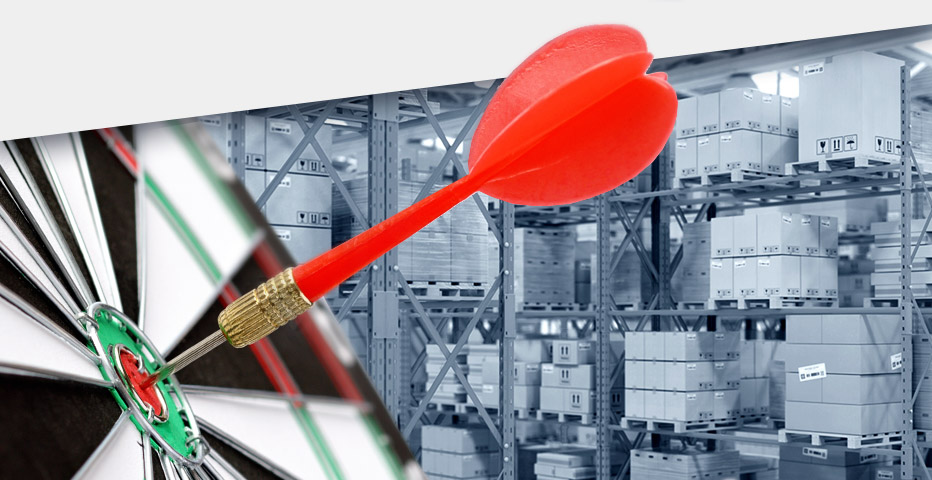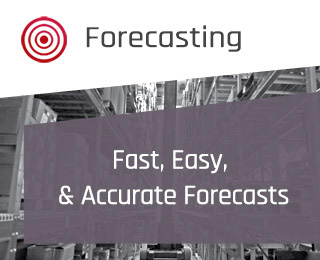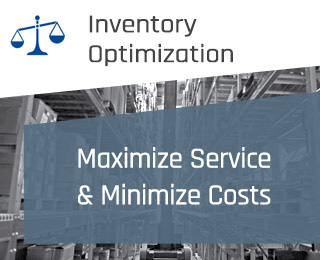Cheat sheet of metric definitions in Smart Inventory Optimization (SIO) workbench
Metric Name |
Where do I see it? |
What is it? |
| Avg Full Cycle SL% | Summary Metrics tab on Summary section | Average of the full cycle service level values of all items in the current group. You can expect to achieve this service level overall when implementing the policies of this scenario. Service level is defined as the probability of meeting all demand and valid values are between 0 and 100%. |
| Total Avg Inventory Value | Summary Metrics tab on Summary section | Sum of the avg inventory value of all items in the current group. Inventory value of an item is its unit cost multiplied by the average expected count of items on hand. You can expect this to be your inventory value on average when implementing the policies of this scenario. |
| Total Annual Operating Cost |
Summary Metrics tab on Summary section and Costs tab on Summary section |
Sum of the total annual operating cost of all items in the current group. Each item’s annual operating cost is the sum of annual ordering cost, annual holding cost and annual shortage cost. |
| Total Orders / Yr | Summary Metrics tab on Summary section | Sum of the number of replenishment transactions expected to be placed per year for all items in the current group. Replenishment transactions are purchase orders for purchased parts and/or work orders for manufactured parts. |
| Fill Rate % | Summary Metrics tab on Summary section | The percentage of units expected to be available on hand at the time of demand compared to the total units demanded across all items in the current group. This metric gives you a sense of the size of stockouts you can expect. This is unlike service level, which gives a sense of the chances of a stockout of any size. |
| ROPValue | Summary Metrics tab on Summary section | The total of summing the inventory value at the reorder point of all items in the current group. This metric is mostly useful when comparing the cost of inventory at the reorder point across scenarios. It is not an expected inventory value because it’s unlikely all item’s on hand values will equal their reorder points at the same time. |
| Avg Order Cycle | Summary Metrics tab on Summary section | The average of the order cycle length in days for all items in the current group. |
| Avg ROP SL% | Drivers tab on Summary section | The average of the reorder point service level values of all items in the current group. Reorder point service level is defined as the probability of meeting all demand while waiting on a replenishment order and on hand inventory has fallen below the reorder point. Valid values are between 0 and 100%. If reset in the What If scenario, this can propagate through all items, resetting each item’s ROP service level so they will achieve a new average as entered. |
| Floor ROP SL% | Drivers tab on Summary section | The smallest reorder point service level value of any items in the current group. Reorder point service level is defined as the probability of meeting all demand while waiting on a replenishment order and on hand inventory has fallen below that reorder point. If reset in the What If scenario, this can propagate through all items, resetting any item’s ROP service level to the newly entered value if it originally was lower. |
| Ceiling ROP SL % | Drivers tab on Summary section | The largest reorder point service level value of any items in the current group. Reorder point service level is defined as the probability of meeting all demand while waiting on a replenishment order and on hand inventory has fallen below that reorder point. If reset in the What If scenario, this can propagate through all items, resetting any item’s ROP service level to the newly entered value if it originally was higher. |
| Total Annual Ordering Cost | Costs tab on Summary section | The sum of the total annual ordering cost of all items in the current group. Each item’s annual ordering cost is the item’s Ordering Cost Per Transaction multiplied by the item’s computed count of Orders Per Year. The item’s ordering cost is either an input from your planning system or an editable value that originates as a global default. |
| Total Annual Holding Cost | Costs tab on Summary section | The sum of the total annual holding cost of all items in the current group. Each item’s annual holding cost is the item’s holding cost multiplied by the item’s forecasted average inventory units. The item’s holding cost is either an input from your planning system or an editable percentage of unit cost that originates as a global default. |
| Total Annual Shortage Cost | Costs tab on Summary section | The sum of the total annual shortage cost of all items in the current group. Each item’s annual shortage cost is the item’s shortage cost multiplied by the item’s forecasted average inventory units. The item’s shortage cost is either an input from your planning system or an editable percentage of unit cost that originates as a global default. |
| Ordering Cost per Transaction | Costs tab on Summary section | The average of the ordering cost per transaction values of all items in the current group. If reset in the What If scenario, this can propagate through the items, setting them equal to the cost entered here. |
| Holding Cost as % of Unit Cost | Costs tab on Summary section | The average percentage entered as the Holding Cost as % of Unit Cost of all items in the current group. If reset in the What If scenario, this can propagate through the items, setting them equal to the percentage entered here. |
| Shortage Cost as % of Unit Cost | Costs tab on Summary section | The average percentage entered as the Shortage Cost as % of Unit Cost of all items in the current group. If reset in the What If scenario, this can propagate through the items, setting them equal to the percentage entered here. |
| Average Period Demand | Actuals tab on the Items section | Total Annual Demand of the item in the past rolling year divided by the number of periods in a year that have non-zero data. For example, if SIO is configured with monthly periods, it is last year’s demand divided by the number of months last year that had non zero demand. |
| Total Annual Demand | Actuals tab on the Items section | Sum of demand in the past rolling year. |
| Total Overall Demand | Actuals tab on the Items section | Sum of all demand used in when forecasting the item. |
| Current On Hand | Actuals tab on the Items section | On Hand count most recently supplied to Smart for the item. This is for reference and is not used in any forecasting calculation. |
| Current in Transit | Actuals tab on the Items section | Count of items currently on open purchase orders associated with this location and this product. This is for reference and is not used in any forecasting calculation. |
| Avg LT (Receipts) | Actuals tab on the Items section | The simple average of all purchase orders of this product into this location that have been received in the past rolling year. The value in parenthesis shows the number of purchase orders with receipts that were averaged. This is for reference and is not used in any forecasting calculation, although it can be copied and used as the lead time by a mass apply function on the Driver’s tab. |
| SL% | Forecasted Metrics tab on the Items section | Service level percent. The projected reorder point service level that is expected for the item given its inventory policy. Reorder point service level is defined as the probability of meeting all demand while waiting on a replenishment order and on hand inventory has fallen below the reorder point. Valid values are between 0 and 100%. This output of a forecast computation is for reference but edits to desired reorder point service level can be made on the Driver’s tab. |
| FR % | Forecasted Metrics tab on the Items section | Fill rate percent. The percentage of units expected to be available on hand at the time of demand compared to the total units demanded once on hand have fallen below the reorder point and replenishment is in progress. This metric gives you a sense of the size of stockouts you can expect given the reorder point chosen in this scenario. This is unlike service level, which gives a sense of the chances of a stockout of any size. This output of a forecast computation is for reference. |
| Full Cycle SL % | Forecasted Metrics tab on the Items section | Full cycle service level percent. You can expect to achieve this service level overall when implementing the policies of this scenario. Service level is defined as the probability of meeting all demand and valid values are between 0 and 100%. This output of a forecast computation is for reference. |
| Full Cycle FR % | Forecasted Metrics tab on the Items section | Full cycle fill rate percent. The percentage of units expected to be available on hand at the time of demand compared to the total units demanded across all items in the current group. This metric gives you a sense of the size of stockouts you can expect. This is unlike service level, which gives a sense of the chances of a stockout of any size. This output of a forecast computation is for reference. |
| Recommended OQ | Forecasted Metrics tab on the Items section | A modification on the Economic OQ that ensures that the order quantity will be more than the average lead time demand and takes into account any ordering constraints entered in the Ordering Rules tab. This output based on an industry standard EOQ calculation is for reference, but it can be used to modify the inventory policy using Mass Apply on the Driver’s tab. |
| Economic OQ | Forecasted Metrics tab on the Items section | The economic order quantity computed for the item based on it’s average monthly demand and it’s holding and ordering costs (or their estimates) entered on the Costs tab. This output of an industry standard EOQ calculation is for reference. |
| ROP Value | Forecasted Metrics tab on the Items section | The reorder point of the item multiplied by its cost per unit. This output of a forecast computation is for reference. |
| Order Cycle | Forecasted Metrics tab on the Items section | The predicted number of periods, on average, between orders. This output of a forecast computation is for reference. |
| Avg inventory Value | Forecasted Metrics tab on the Items section | The average of the expected on hand for this item, multiplied by its unit cost. This is the middle of the range around which the inventory value is likely to fluctuate. This output of a forecast computation is for reference. |
| Avg inventory Value | Forecasted Metrics tab on the Items section | The average of the expected on hand for this item, multiplied by its unit cost. This is the middle of the range around which the inventory value is likely to fluctuate. This output of a forecast computation is for reference. |
| Current Inventory Value | Forecasted Metrics tab on the Items section | On Hand multiplied by the cost per unit. |
| Total Annual Operating Cost | Forecasted Metrics tab on the Items section | The total of the expected holding, ordering, and shortage costs for the item over one year. Costs are based on values coming from your planning system or estimates entered in the Costs tab. |
| Lead Time Demand | Forecasted Metrics tab on the Items section | The forecasted demand over the lead time for the lead time entered in the Driver’s tab for this scenario. The only way to effect this computed output is to edit inputs of lead time or of demand history and/or forecast parameters as associated with this item in Smart Demand Planner.) The lead time demand plus safety stock as shown on the Driver’s tab is equal to the item’s reorder point. |
| ROP Units | Drivers tab on the Items section | Reorder Point Units. Inventory policy of reorder point. May or may not be visible, depending on configuration of inventory policy setting. |
| OQ Units | Drivers tab on the Items section | Order Quantity Units. Inventory policy of order quantity. May or may not be visible, depending on configuration of inventory policy setting. |
| Max Units(PSL) | Drivers tab on the Items section | Inventory policy of Max. May or may not be visible, depending on configuration of inventory policy setting. |
| Safety Stock | Drivers tab on the Items section | Inventory policy of safety stock. May or may not be visible, depending on configuration of inventory policy setting. |
| ROP SL% | Drivers tab on the Items section | Reorder Point Service Level Percent. The service level for an item once on hand has fallen to the reorder point and an order is required and in transit. |
| Lead Time (in days) | Drivers tab on the Items section | Replenishment lead time. The number of days between triggering replenishment and the received item available in stock. |
| Cost/Unit | Costs tab on the Items section | Cost per unit in the unit associated with inventory. This is editable, so you can see the effect of a new cost per unit. |
| Annual Ordering Cost | Costs tab on the Items section | Orders Per Year multiplied by Ordering Cost Per Transaction. Orders Per Year is found on the Forecasted Metrics tab. |
| Annual Holding Cost | Costs tab on the Items section | Average Inventory Units multiplied by count of periods in a year multiplied by Holding Cost Per Period (which might be provided from the ERP or computed from Holding Cost as % of Unit Cost). |
| Annual Shortage Cost | Costs tab on the Items section |
This is computed by first computing FractionOfUnitsNotFilled = 1 minus (Fill Rate Percent / 100) . Fill Rate Percent is found on the Forecasted Metrics tab. Then, Annual Shortage Cost = FractionOfUnitsNotFilled multiplied by Average Forecast Per Period multiplied by Shortage Cost Per Unit multiplied by count of periods in a year. The Shortage Cost Per Unit might be provided from the ERP or computed from Shortage Cost as a % of Unit Cost. |
| Ordering Cost per Transaction | Costs tab on the Items section | Might be provided from the ERP, set with a global default value, or manually entered here. What global default to use can be set in the solution design. |
| Holding Cost as % of Unit Cost | Costs tab on the Items section | The percentage to use when estimating Holding Cost based on Cost/Unit might be provided from the ERP, set with a global default value, or manually entered here. What global default to use can be set in the solution design. |
| Shortage Cost as % of Unit Cost | Costs tab on the Items section | The percentage to use when estimating Shortage Cost based on Cost/Unit might be provided from the ERP, set with a global default value, or manually entered here. What global default to use can be set in the solution design. |
| Optimize | Optimization tab on the Items section |
The checkbox indicates if policy should be computed with the optimization function. Check if the item should have policy computed automatically for the lowest cost, based on the sum of Annual Ordering Cost, Annual Holding Cost, and Annual Shortage cost. These costs are visible on the Costs tab. Uncheck if the item policy should be computed based on values in the Drivers tab. |
| SL % Floor Constraint | Optimization tab on the Items section | If Optimize is checked, a non-zero SL% Floor constraint must be entered, though zero is the default. This represents the minimally acceptable service level for that item, even if a lower service level would result in a lower cost. |
| Min | Ordering Rules tab on the Items section |
Minimum Order Quantity constraint. No computed order quantity will be smaller than the Min. It might be provided from the ERP or manually entered here to see what would happen were it changed.
It is used by the mass apply function on the Driver’s tab for OQ Units or Max Units to constraint the output as well as contributing to the constraints on Economic OQ to produce the Recommended OQ value. |
| Multi | Ordering Rules tab on the Items section |
Order Multiple constraint. No computed order quantity will be other than a multiple of the Multi. It might be provided from the ERP or manually entered here to see what would happen were it changed.
It is used by the mass apply function on the Driver’s tab for OQ Units or Max Units to constraint the output as well as contributing to the constraints on Economic OQ to produce the Recommended OQ value. |
| All fields on this tab | Attributes tab on the Items section | All the fields on this tab are custom and correspond to fields pulled into Smart from your ERP for filtering, sorting, and grouping purposes. |
Supply Chain industries mainly rely on the materials to progress and grow, and maintaining all these parts available, requires large amount of investment.
Supply chain management and inventory optimization are a major source of savings and necessary for the efficient functioning of the company. Smart Inventory Planning and Optimization helps you keep the right inventory levels when you have intermittent demand. Our main goal is to ensure that the crucial parts are always available, helping your company Increase service levels, and reduce inventory costs.
Contact Us Today for More Information
If you request a demo, one of our specialists will show you how Smart can help, using your own inventory data!




